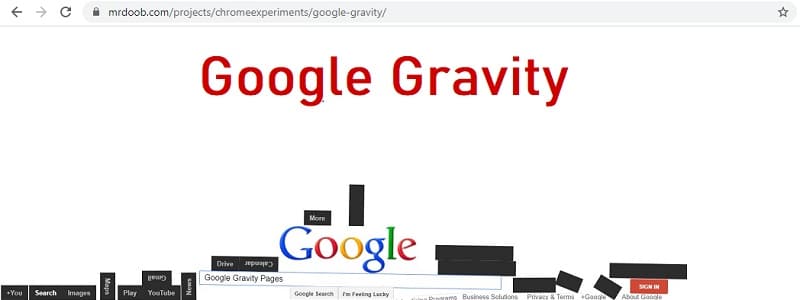4 Tips to Make Your Own Google Gravity Pages

TechsPlace | Google creates unique homepage concepts during national holidays and other significant dates. Google gravity is more or less the same. It is a substitute homepage that, unlike other themes, is always at your disposal. A Google Gravity page operates just like the standard search page save for the fact that your results are organized differently.
The theme was built as a trial in 2009 but was withdrawn shortly after. However, it was reanimated by Ricardo Cabello, popularly known as Mr. Doob. This post is going to guide you on four easy steps to make Google Gravity pages.
Google Gravity’s source code is developed in simple Javascript by using the Box2D open-source engine commonly used for games. Isolate the Javascript and add it to your Go application then name your components with Box2D to create Google Gravity pages. You can then use tools for monitoring app metrics in Go to ensure that is working as intended.
Steps to Creating Google Gravity Pages
Creating a Google Gravity Page for your application is pretty easy. Simply follow this step by step guide and you will be done in no time.
1. Design Your HTML Text
The first step is creating the HTML page on the site where you would like to implement the Google Gravity concept. Simply type your HTML code into your text editor and save it with a .html extension. You can then proceed to execute your HTML file from where it is saved onto the page you want.
2. Transfer the Javascript Files
The JavaScript code needs to be distinguished into two distinct files. They are downloadable online but make sure that they are saved with a .js extension. Once downloaded, put them alongside the HTML file you created.
3. Insert the Javascript Documents
Next, include the JavaScript texts you have downloaded into the HTML file before the closing tag
A JavaScript file basically contains Javascript code that can be used to carry out JavaScript instructions on your web page. This process is commonly known as file handling. It includes functions that can do the following:
- Certify form fields
- Allow scrolling images
- Close and open windows
- Creating dropdown menus
4. Enter the Class Name
Finally, include the box2d class title to every component that requires it to be dropped. Box2D helps you to create realistic motions that are guaranteed to improve the user experience on your Go application.
You select the objects you would like to apply it to and it simulates their movements. Box2D adds lifelike aspects like friction, collision, and the gravity effect you need to create your Google Gravity page. Now you can open your HTML file on your site and marvel at your very own Google Gravity page.
How Google Gravity Works
Web pages that have Google Gravity are characterized by icons dropping to the bottom of the page after a couple of seconds. Some icons land as they were while others appear inverted or slanting.
Google Gravity acts as some form of a game that will hook your users. You can move the dropped icons at the bottom and play around with them. Users can click on them, drag them upward, and drop them back down.
The Google Gravity theme is not only an exciting feature for your users to play with: it works as efficiently as the standard search page. You will be required to input your query into the search area and press “Enter”. Your results will drop to the bottom of the web page instead of appearing in a list. You can move the results around your screen and press any link to view them in a new tab.
Application Performance Monitoring
Application metrics are essential when it comes to monitoring your application performance. Performance testing your application can help you identify the following problems:
- Possible memory leaks
- Poor application output
- High CPU usage for your application’s level of output
- Sluggish HTTP response time on several routes
- Slowdown caused by high demand
Advantages of Monitoring Your Go Application
Performance monitoring tools keep track of your application constantly and collect data on how it is performing. This data is translated into regular reports and graphs that can help you come up with ways to improve performance.
Using Google Gravity pages on your application is usually geared towards making it more appealing to existing and new users. However, the most reliable way to check how your Google Gravity pages are impacting your website is by using application performance monitoring. Here are some of the advantages of testing your Go application.
• Boost User Experience
There are tens if not hundreds of similar applications in the market and you need to make yours stand out from the crowd. Users are in constant need of improved web applications that are fast and appealing. Incorporating these modern aspects into your application is not enough. You need to monitor your metrics so you can identify the features negatively affecting your app and get rid of them.
• Prevent Losses
Applications are prone to attacks and delays. Such disruptions can negatively affect the reputation of your brand, additionally, you may lose loyal customers, income, or even become liable for fines. Monitoring tools can notify you when your app is experiencing delays so you can get it back up as soon as possible.
Conclusion
Using Google Gravity is a modern way to entice your customers and make them spend even more time on your web application. However, you must check that the theme is actually improving your customers’ user experience. We hope that you found this article helpful. If you do try this out, be sure to follow it up with an application monitoring tool to check how it is performing.
This article is contributed by guest author on techsplace.com.





